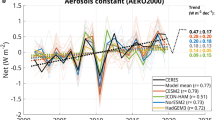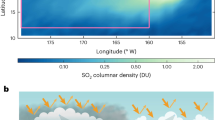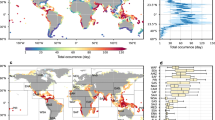Abstract
Owing to the turbulent nature of the ocean, mesoscale eddies are omnipresent. The impact of these transitory and approximately circular sea surface temperature fronts on the overlying atmosphere is not well known. Stationary fronts such as the Gulf Stream have been reported to lead to pronounced atmospheric changes1,2. However, the impact of transient ocean eddies on the atmosphere has not been determined systematically, except on winds and to some extent clouds3,4,5,6. Here, we examine the atmospheric conditions associated with over 600,000 individual eddies in the Southern Ocean, using satellite data. We show that ocean eddies locally affect near-surface wind, cloud properties and rainfall. The observed pattern of atmospheric change is consistent with a mechanism in which sea surface temperature anomalies associated with the oceanic eddies modify turbulence in the atmospheric boundary layer. In the case of cyclonic eddies, this modification triggers a slackening of near-surface winds, a decline in cloud fraction and water content, and a reduction in rainfall. We conclude that transient mesoscale ocean structures can significantly affect much larger atmospheric low-pressure systems that swiftly pass by at the latitudes investigated.
This is a preview of subscription content, access via your institution
Access options
Subscribe to this journal
Receive 12 print issues and online access
$259.00 per year
only $21.58 per issue
Buy this article
- Purchase on Springer Link
- Instant access to full article PDF
Prices may be subject to local taxes which are calculated during checkout



Similar content being viewed by others
References
Hobbs, P. V. The Gulf Stream rainband. Geophys. Res. Lett. 14, 1142–1145 (1987).
Minobe, S., Kuwano-Yoshida, A., Komori, N., Xie, S-P. & Small, R. J. Influence of the Gulf Stream on the troposphere. Nature 452, 206–209 (2008).
White, W. B. & Annis, J. L. Coupling of extratropical mesoscale eddies in the ocean to westerly winds in the atmospheric boundary layer. J. Phys. Oceanogr. 33, 1095–1107 (2003).
Chelton, D. B., Schlax, M. G., Freilich, M. H. & Milliff, R. F. Satellite measurements reveal persistent small-scale features in ocean winds. Science 303, 978–983 (2004).
Park, K-A., Cornillon, P. & Codiga, D. L. Modification of surface winds near ocean fronts: Effects of Gulf Stream rings on scatterometer (QuikSCAT, NSCAT) wind observations. J. Geophys. Res. 111, C03021 (2006).
Bryan, F. O. et al. Frontal scale air–sea interaction in high-resolution coupled climate models. J. Clim. 23, 6277–6291 (2010).
Xie, S-P. Satellite observations of cool ocean–atmosphere interaction. Bull. Amer. Meteorol. Soc. 85, 195–208 (2004).
O’Neill, L. W., Chelton, D. B., Esbensen, S. K. & Wentz, F. J. High-resolution satellite measurements of the atmospheric boundary layer response to SST variations along the Agulhas Return Current. J. Clim. 18, 2706–2723 (2005).
Liu, W. T., Xie, X. & Niiler, P. P. Ocean–atmosphere interaction over Agulhas extension meanders. J. Clim. 20, 5784–5797 (2007).
Xu, H., Xu, M., Xie, S-P. & Wang, Y. Deep atmospheric response to the spring Kuroshio over the East China Sea. J. Clim. 24, 4959–4972 (2011).
Ferrari, R. & Wunsch, C. Ocean circulation kinetic energy: Reservoirs, sources, and sinks. Annu. Rev. Fluid Mech. 41, 253–282 (2009).
Hausmann, U. & Czaja, A. The observed signature of mesoscale eddies in sea surface temperature and the associated heat transport. Deep-Sea Res. Part I 70, 60–72 (2012).
Okubo, A. Horizontal dispersion of floatable particles in the vicinity of velocity singularities such as convergences. Deep-Sea Res. 17, 445–454 (1970).
Weiss, J. The dynamics of enstrophy transfer in two-dimensional hydrodynamics. Physica D 48, 273–294 (1991).
Spall, M. A. Midlatitude wind stress-sea surface temperature coupling in the vicinity of oceanic fronts. J. Clim. 20, 3785–3801 (2007).
Small, R. et al. Air–sea interaction over ocean fronts and eddies. Dyn. Atmos. Oceans 45, 274–319 (2008).
Chelton, D. B. & Xie, S-P. Coupled ocean–atmosphere interaction at oceanic mesoscales. Oceanography 23, 52–69 (2010).
Iizuka, S. Simulations of wintertime precipitation in the vicinity of Japan: Sensitivity to fine-scale distributions of sea surface temperature. J. Geophys. Res. 115, D10107 (2010).
Jin, X. et al. SST-wind interaction in coastal upwelling: Oceanic simulation with empirical coupling. J. Phys. Oceanogr. 39, 2957–2970 (2009).
Shuckburgh, E. et al. Mixed layer lateral eddy fluxes mediated by air–sea interaction. J. Phys. Oceanogr. 41, 130–144 (2011).
Wanninkhof, R., Park, G., Chelton, D. B. & Risien, C. M. in Gas Transfer at Water Surfaces 2010 (eds Komori, S., McGillis, W. & Kurose, R.) 431–444 (Kyoto University Press, 2011).
Mikaloff Fletcher, S. E. et al. Inverse estimates of anthropogenic CO2 uptake, transport, and storage by the ocean. Glob. Biogeochem. Cycles 20, GB2002 (2006).
McGillicuddy, D. J. et al. Eddy/wind interactions stimulate extraordinary mid-ocean plankton blooms. Science 316, 1021–1026 (2007).
O’Neill, L. W. Wind speed and stability effects on coupling between surface wind stress and SST observed from buoys and satellite. J. Clim. 25, 1544–1569 (2012).
Isern-Fontanet, J., Garcı´a-Ladona, E. & Font, J. Identification of marine eddies from altimetric maps. J. Atmos. Ocean. Technol. 20, 772–778 (2003).
Hilburn, K. A., Wentz, F. J., Smith, D. K. & Ashcroft, P. D. Correcting active scatterometer data for the effects of rain using passive radiometer data. J. Appl. Meteorol. Climatol. 45, 382–398 (2006).
Wentz, F. J. A well-calibrated ocean algorithm for special sensor microwave/imager. J. Geophys. Res. 102, 8703–8718 (1997).
Liu, W., Xie, X. & Tang, W. in Oceanography from Space: Revisited (eds Barale, V., Alberotanza, L. & Gower, J.) Ch. 6, 93–111 (Springer Dordrecht Heidelberg, 2010).
Sallée, J. B., Speer, K. & Morrow, R. Response of the antarctic circumpolar current to atmospheric variability. J. Clim. 21, 3020–3039 (2008).
Acknowledgements
The Center for Climate Systems Modelling (C2SM) at ETH Zürich provided financial support for this project.
Author information
Authors and Affiliations
Contributions
I.F., M.M. and N.G. conceived the study, I.F. performed all analyses with support from M.M. R.K. provided support concerning statistical methods. All authors contributed to the interpretation and writing of the manuscript.
Corresponding author
Ethics declarations
Competing interests
The authors declare no competing financial interests.
Supplementary information
Supplementary Information
Supplementary Information (PDF 7463 kb)
Rights and permissions
About this article
Cite this article
Frenger, I., Gruber, N., Knutti, R. et al. Imprint of Southern Ocean eddies on winds, clouds and rainfall. Nature Geosci 6, 608–612 (2013). https://doi.org/10.1038/ngeo1863
Received:
Accepted:
Published:
Issue Date:
DOI: https://doi.org/10.1038/ngeo1863
This article is cited by
-
Assessment of global eddies from satellite data by a scale-selective eddy identification algorithm (SEIA)
Climate Dynamics (2024)
-
Contrasts of bimodal tropical instability waves (TIWs)-induced wind stress perturbations in the Pacific Ocean among observations, ocean models, and coupled climate models
Journal of Oceanology and Limnology (2024)
-
The importance of the transient variability for the warm-season Gulf Stream convergence zone
Climate Dynamics (2023)
-
Interannual variability of eddy kinetic energy in the South China Sea related to two types of winter circulation events
Journal of Oceanology and Limnology (2023)
-
Three-Dimensional Climatological Structures of the Arabian Sea Eddies and Eddy-Induced Flux
Journal of Ocean University of China (2023)



